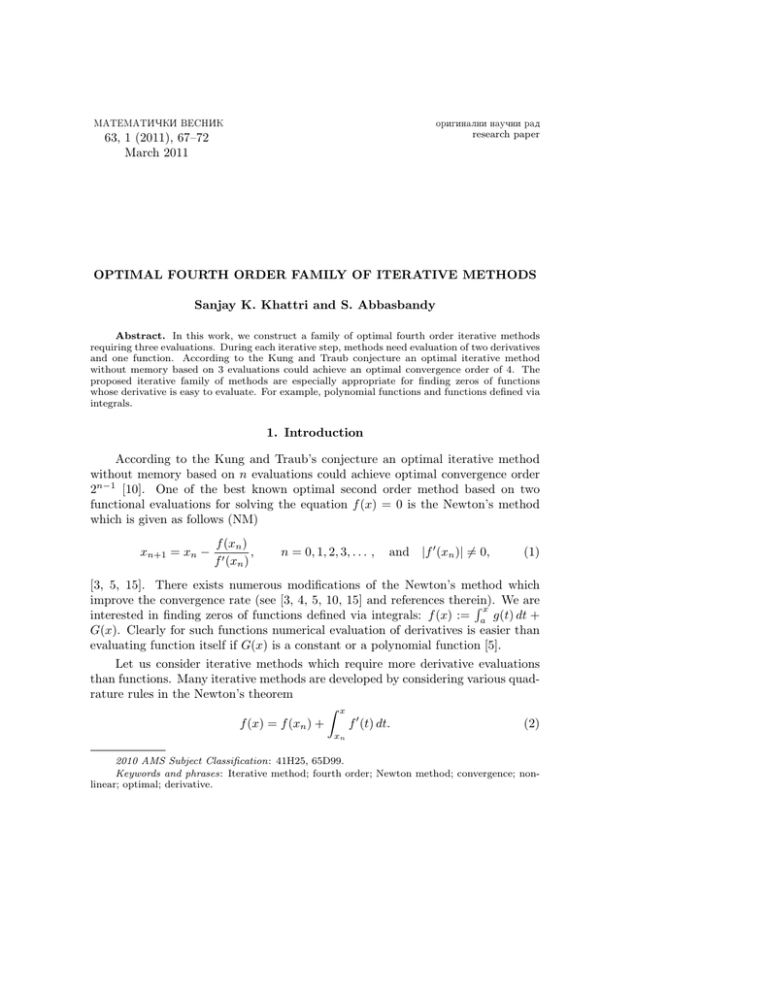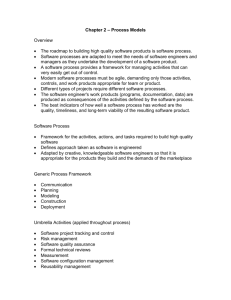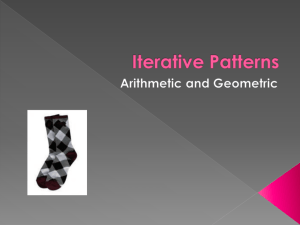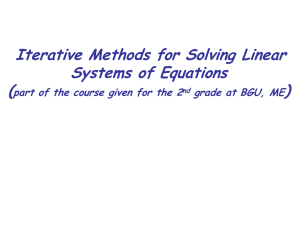63, 1 (2011), 67–72 March 2011 Sanjay K. Khattri and S. Abbasbandy
advertisement

MATEMATIQKI VESNIK originalni nauqni rad research paper 63, 1 (2011), 67–72 March 2011 OPTIMAL FOURTH ORDER FAMILY OF ITERATIVE METHODS Sanjay K. Khattri and S. Abbasbandy Abstract. In this work, we construct a family of optimal fourth order iterative methods requiring three evaluations. During each iterative step, methods need evaluation of two derivatives and one function. According to the Kung and Traub conjecture an optimal iterative method without memory based on 3 evaluations could achieve an optimal convergence order of 4. The proposed iterative family of methods are especially appropriate for finding zeros of functions whose derivative is easy to evaluate. For example, polynomial functions and functions defined via integrals. 1. Introduction According to the Kung and Traub’s conjecture an optimal iterative method without memory based on n evaluations could achieve optimal convergence order 2n−1 [10]. One of the best known optimal second order method based on two functional evaluations for solving the equation f (x) = 0 is the Newton’s method which is given as follows (NM) xn+1 = xn − f (xn ) , f 0 (xn ) n = 0, 1, 2, 3, . . . , and |f 0 (xn )| 6= 0, (1) [3, 5, 15]. There exists numerous modifications of the Newton’s method which improve the convergence rate (see [3, 4, 5, 10, 15] and references therein). R x We are interested in finding zeros of functions defined via integrals: f (x) := a g(t) dt + G(x). Clearly for such functions numerical evaluation of derivatives is easier than evaluating function itself if G(x) is a constant or a polynomial function [5]. Let us consider iterative methods which require more derivative evaluations than functions. Many iterative methods are developed by considering various quadrature rules in the Newton’s theorem Z x f 0 (t) dt. (2) f (x) = f (xn ) + xn 2010 AMS Subject Classification: 41H25, 65D99. Keywords and phrases: Iterative method; fourth order; Newton method; convergence; nonlinear; optimal; derivative. 68 S. K. Khattri, S. Abbasbandy Weerakoon et al. obtained the following cubically convergent iterative method (WF) xn+1 = xn − 2f (xn ) , (f 0 (xn ) + f 0 (xn − f (xn )/f 0 (xn ))) (3) by using the trapezoidal rule in the equation (2) [15]. While Frontini et al. considered the midpoint quadrature rule in (2) and Homieier et al. considered properties of vanishing derivative to obtain the following cubical iterative method (FH) xn+1 = xn − f (xn ) , f 0 (xn − f (xn )/(2 f 0 (xn ))) (4) [3, 4]. Furthermore Homeier derived the following cubically convergent iterative method (HH) µ ¶ 1 1 f (xn ) + , (5) xn+1 = xn − 2 f 0 (xn ) f 0 (xn − f (xn )/f 0 (xn )) by using the Newton’s theorem (2) for the inverse function x = f (y) [5]. We notice that the quadratic convergent Newton’s method require evaluations of one function and one derivative while the cubic methods (3)–(5) require evaluations of two derivatives and one function during each iteration. It was shown by the Homeier et al. that finding zeros of functions defined via integrals is easier by the method (4) than by the optimal Newton method [5]. The cubic methods (3)–(5) require three evaluations. Therefore by the Kung and Traub conjecture they are not optimal [10]. In this work, we develop an optimal family of quartically convergent methods requiring two evaluations of derivatives and one evaluation of function during each iteration. The next section presents our contribution. 2. New optimal fourth order iterative methods To develop optimal methods requesting evaluations of two derivatives and one function during each iteration, we consider the iterative method 2 f (xn ) yn = xn − , 3 f 0 (xn ) · ¶ ¸ µ (6) j 4 P f (xn ) f 0 (yn ) xn+1 = xn − 0 1+ , αj f (xn ) f 0 (xn ) j=1 where αj ∈ R. We prove that the methods of the preceding family are fourth order convergent through the theorem. Theorem 1. Let a sufficiently smooth function f : D ⊂ R → R has a simple root γ ∈ D in the open interval D. Then the methods of the iterative family (6) are at least fourth order convergent if α1 := 21/8 − α4 , α2 := −9/2 − 3α4 and α3 := 15/8 − 3α4 . Here, α4 is a free real parameter. The methods of the family satisfies the error equation ¶ ¸ ·µ 85 1 64 α4 + c2 3 − c2 c3 + c4 e4n + O(e5n ). en+1 = 27 9 9 Optimal fourth order family of iterative methods 69 Proof. The Taylor series expansion of f (x) and f 0 (xn ) around the solution γ is given as ¡ ¢ ¡ ¢ f (xn ) = f 0 (γ) en + c2 en 2 + c3 en 3 + c4 en 4 + O en 5 , (7) ¢ ¡ ¡ 4¢ 0 0 2 3 (8) f (xn ) = f (γ) 1 + 2 c2 en + 3 c3 en + 4 c4 en + O en . Using the equations (7) and (8) into the first step of the proposed method (6), we obtain ¢ ¡ ¡ ¢ yn − γ = 1/3en + 2/3 c2 en 2 + 4/3 c3 − 4/3 c2 2 en 3 + O en 4 , (9) the Taylors series expansion of f 0 (yn ) around the solution γ f 0 (yn ) = ∞ P ck (yn − γ)k , (10) k=1 from the preceding equation and the equation (9), we obtain ¡ ¢ 2 1 f 0 (yn ) = f 0 (γ) + f 0 (γ)c2 en + f 0 (γ) 4 c2 2 + c3 en 2 3 3 ¡ ¢ ¡ ¢ 4 0 − f (γ) −27 c3 c2 + 18 c2 3 − c4 en 3 + O en 4 . (11) 27 Dividing equations (11) and (12) yields µ ¶ f 0 (yn ) 4 8 2 = 1 − c2 en + 4 c2 − c3 en 2 f 0 (xn ) 3 3 µ ¶ ¡ ¢ 40 32 3 104 + c3 c2 − c2 − c4 en 3 + O en 4 . (12) 3 3 27 Finally substituting from equations (7), (8) and (12) into the second step of the proposed method (6) 1 en+1 = γ + (−α1 − α2 − α4 − α3 ) en + c2 (19 α4 + 7 α1 + 15 α3 + 11 α2 + 3) en 2 3 ³³ 38 ´ 22 + α4 + 10 α3 + 14/3 α1 + α2 + 2 c3 3 3 ³ ´ ´ 130 22 70 + −34 α4 − α2 − α1 − α3 − 2 c2 2 en 3 9 3 3 ³ 497 289 131 77 185 + α4 c4 + α2 c4 + α3 c4 + 3 c4 + 4 c2 3 − α1 c2 c3 + α1 c4 27 27 9 3 27 2584 460 4252 64 253 − 7 c3 c2 + α3 c2 3 + α2 c2 3 + α4 c2 3 + α1 c2 3 − α3 c3 c2 27 9 27 3 3 ´ 463 373 − α2 c3 c2 − α4 c3 c2 en 4 + O(en 5 ). (13) 9 3 In the preceding error equation the second and the third order terms are zero if and only if: α1 = 21/8 − α4 , α2 = −9/2 + 3α4 and α3 = 15/8 − 3α4 . Therefore the proposed method is at least fourth order convergent for any real choice of the parameter α4 . This completes our proof. 70 S. K. Khattri, S. Abbasbandy As positively remarked by the reviewer: the first-step of the proposed method is similar to the first-step of the Jarratt’s method, may be referred to as the Jarratt’s correction, and to construct optimal fourth order methods Jarratt was the first to introduce the ratio f 0 (yn )/f 0 (xn ). Jarratt’s method is given as (JR) µ ¶ 2 f (xn ) f (xn ) 3 f 0 (yn ) − f 0 (xn ) 1 − , (14) yn = xn − , x = x − n+1 n 3 f 0 (xn ) f 0 (xn ) 2 3f 0 (yn ) − f 0 (xn ) [6]. For other fourth and higher order optimal methods, we refer to the admirable literature [2, 8, 9, 11, 12, 13, 14]. 4. Numerical Example All the computations reported here are done in the programming language C++ on the Acer Aspire 5720ZG with Intel dual-core processor T2310 and with 2GB of memory. For numerical precision, we are using the C++ library ARPREC [1]. The ARPREC library supports arbitrarily high level of numeric precision. In the program, the precision in decimal digits is set at 2005 with the command “mp::mp init(2005)”. To evaluate the integral the Tanh − Sinh quadrature scheme is used. For evaluating quadrature to high precision, in the package ARPREC the primary user working precision is set at 600 digits while the secondary working precision is set at 1000 digits. For convergence, it is required that the distance of two consecutive approximations (|xn+1 − xn |) be less than ². And, the absolute value of the function (|f (xn )|) also referred to as residual be less than ². Apart from the convergence criteria, our algorithm also uses maximum allowed iterations as stopping criterion. Thus our algorithm stops if (i) |xn+1 − xn | < ², (ii) |f (xn )| < ², (iii) itr > maxitr. Here, ² = 1 ×10−300 , itr is the iteration counter for the algorithm and maxitr = 100. We test the methods (1), (3) and the proposed method (6) for the following functions Z x f1 (x) = 2 exp t cos t dt + 1 + exp π, γ = π, Z x0 f2 (x) = t log (t + 1) dt − 1/4, γ = 1, Z0 x f3 (x) = [exp −t3 /2 − exp t8 /2] dt + 1/10, γ ≈ 0.9054. 0 To minimize the asymptotic error constant, we choose α4 = −255/64 in the proposed method (PM) (6). Performance of the present method (6), the Newton method (1), the cubic method (3) and well known Jarratt’s method (14) is compared in the Tables 1 and 2. The Tables 1 and 2 present distance between two consecutive iteration and CPU time required by the three methods. Computational results show that the proposed method and the Jarratt’s method require substantial less time to converge than the optimal Newton method (1) or the third order method (3). Which is expected because evaluation of derivatives for the functions f1 (x), f2 (x) and f3 (x) is computationally less expensive than evaluating functions. 71 Optimal fourth order family of iterative methods Consequently the optimal methods which require more derivative evaluations than function evaluations are suitable for functions defined via integrals. To compute the CPU time required, we are using the ARPREC command time(null) [1]. f1 (x) with x0 = 3.1 NM PM WF f2 (x) with x0 = 2.0 JR NM PM WF JR 4.2 × 10−2 1.4 × 10−1 8.1 × 10−2 4.1 × 10−1 3.7 × 10−1 8.8 × 10−1 8.2 × 10−1 9.3 × 10−1 9.0 × 10−4 2.3 × 10−4 1.2 × 10−5 1.1 × 10−7 1.2 × 10−1 1.1 × 10−1 1.6 × 10−1 6.7 × 10−2 4.0 × 10−7 2.7 × 10−17 2.2 × 10−14 2.3 × 10−27 1.2 × 10−2 1.1 × 10−5 2.9 × 10−3 8.6 × 10−6 8.1 × 10−14 2.0 × 10−80 5.9 × 10−34 1.1 × 10−1221.3 × 10−4 3.0 × 10−20 2.1 × 10−8 2.4 × 10−24 1.1 × 10−27 1.1 × 10−3202.0 × 10−1012.0 × 10−4881.4 × 10−8 4.4 × 10−80 7.0 × 10−24 3.2 × 10−96 5.3 × 10−54 ******* 7.1 × 10−258 ******* 1.6 × 10−16 9.4 × 10−3205.9 × 10−70 4.8 × 10−312 −107 −674 1.6 × 10 ******* 4.1 × 10 ******* 2.6 × 10−65 ******* 1.9 × 10−159 ******* 1.4 × 10−210 ******* ******* ******* 3.7 × 10−130 ******* 6.9 × 10−457 ******* 9.8 × 10−429 ******* ******* ******* 5.3 × 10−254 ******* ******* ******* ******* ******* ******* ******* 1.2 × 10−534 ******* ******* ******* time = 113 time = 46 time = 76 time = 41 time = 122 time = 36 time = 79 time = 44 Table 1. |xn+1 − xn | with n ≥ 1 and total CPU time required for the function f1 (x) and f2 (x). NM PM 10−1 WF 10−1 JR 10−1 2.1 × 4.9 × 10−2 6.2 × 10−4 9.2 × 10−8 1.0 × 1.2 × 10−4 2.6 × 10−16 1.2 × 10−65 4.1 × 10−16 7.1 × 10−32 9.1 × 10−64 7.1 × 10−128 8.1 × 10−264 9.1 × 10−260 2.1 × 10−63 4.1 × 10−1010 8.1 × 10−189 ******* 4.3 × 10−534 ******* ******* ******* ******* 5.1 × 10−528 ******* time = 142 time = 44 7.1 × 7.4 × 10−2 6.6 × 10−7 3.1 × 10−21 ******* time = 71 3.2 × 10−2 1.2 × 10−6 8.3 × 10−23 4.4 × 10−72 6.1 × 10−280 1.4 × 10−1090 ******* ******* ******* ******* time = 42 Table 2. |xn+1 − xn | with n ≥ 1 and total CPU time required for the function f3 (x). Acknowledgements. We are grateful to the reviewer for the constructive remarks and suggestions which have enhanced our work. REFERENCES [1] ARPREC, C++/Fortran-90 arbitrary precision package. Available at: http://crd.lbl.gov/ ~dhbailey/mpdist/. [2] C. Chun, Some fourth-order iterative methods for solving nonlinear equations, Appl. Math. Comput. 195 (2008), 454–459. [3] M. Frontini, E. Sormani, Some variant of Newton’s method with third-order convergence, Appl. Math. Comput. 140 (2003), 419–426. [4] H.H.H. Homeier, A modified Newton method for rootfinding with cubic convergence, J. Comput. Appl. Math. 157 (2003), 227–230. 72 S. K. Khattri, S. Abbasbandy [5] H.H.H. Homeier, On Newton-type methods with cubic convergence, J. Comput. Appl. Math. 176 (2005), 425–432. [6] P. Jarratt, Some fourth order multipoint iterative methods for solving equations, Math. Comp. 20 (1966), 434–437. [7] S.K. Khattri, Altered Jacobian Newton iterative method for nonlinear elliptic problems, IAENG Int. J. Appl. Math. 38 (2008). [8] R. King, A family of fourth order methods for nonlinear equations, SIAM J. Numer. Anal. 10 (1973), 876–879. [9] J. Kou, Y. Li, X. Wang, A composite fourth-order iterative method, Appl. Math. Comput. 184 (2007), 471–475. [10] H.T. Kung, J.F. Traub, Optimal order of one-point and multipoint iteration, J. Assoc. Comput. Math. 21 (1974), 634–651. [11] A.K. Maheshwari, A fourth-order iterative method for solving nonlinear equations, Appl. Math. Comput. 211 (2009), 383–391. [12] A.M. Ostrowski, Solution of Equations and Systems of Equations, Academic Press, New York-London, 1966. [13] M.S. Petković, On a general class of multipoint root-finding methods of high computational efficiency, SIAM. J. Numer. Anal. 47 (2010), 4402–4414. [14] J.F. Traub, Iterative Methods for the Solution of Equations, Prentice Hall, New York, 1964. [15] S. Weerakoon, T.G.I. Fernando, A variant of Newton’s method with accelerated third-order convergence, Appl. Math. Lett. 13 (2000), 87–93. (received 11.03.2010; in revised form 17.04.2010) Sanjay K. Khattri, Department of Engineering, Stord Haugesund University College, Norway E-mail: sanjay.khattri@hsh.no S. Abbasbandy, Department of Mathematics, Science and Research Branch, Islamic Azad University, Tehran 14515/775, Iran. E-mail: abbasbandy@yahoo.com







